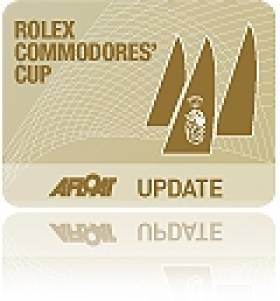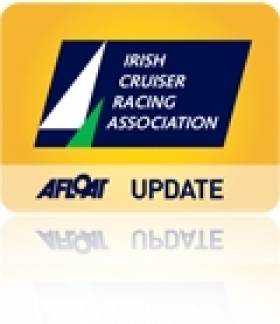Displaying items by tag: Mark Mills
Mark Mills is Designer of Choice for 2010 Commodores' Cup
The ten challenges lodged for the 2010 is the smallest Commodores' Cup fleet size since 2000 when seven teams contested the trophy but in the battle of the designers it's Afloat's sailor of the year Mark Mills from Wicklow who comes out on top with six of his designs participating this weekend.
The USA has won the event twice (1992 & 94), GBR twice (2004 & 2008), France twice (2002 & 2006), Germany once (1998), the Channel Islands once (2000) and England once (1998).
Hong Kong has competed twice before in 1992 and 2008. South Africa is competing for the first time. France has competed in every event since 2000.
Racing commences on Sunday, 15 August, with the first race scheduled for 10.30AM and, as one would expect, there has been no shortage of activity since close of challenges for the 10th biennial Rolex Commodores' Cup.
Whilst the single team nations, Ireland, South Africa and Hong Kong, set out their stall early, identifying boats and team members, the multi-team nations, United Kingdom and France have faced more complex decision-making in defining the composition of their various line-ups.
Ten teams, comprising a total of thirty yachts spread over five nations, will be on the start line all fired up in anticipation of a highly competitive event. Teams are made up of three boats, one in each of three precise rating bands. The full National team listings are available HERE and Ireland's crew list HERE. Below are some more highlights:
Class 1
Highest Rating: GBR2045R Alice II Simon Henning (GBR White) Farr 45 - Rating: 1.226
Lowest Ratings: GBR851R Cracklin' Rosie Brian Wilkinson (GBR Black) Corby 40 - Rating: 1.110
FRA36777 Codiam N. Loday & C. Nicoleau (FRA Blue) Grand Soleil 43 – Rating: 1.110
Largest Yacht: GBR2045R Alice II Simon Henning (GBR White) Farr 45 – 13.8m
Smallest Yachts: FRA35439 Inis Mor Laurent Gouy (FRA Yellow) Ker 39 – 11.8m
IRL3939 Antix Anthony O'Leary (IRL) Ker 39 – 11.8m
Class 2
Highest Rating: HKG2097 Blondie IV Anthony Day (HKG) King 40 – Rating: 1.119
Lowest Rating: GBR42N La Reponse A McIrvine & P Morton (GBR White) First 40 – Rating: 1.085
Largest Yachts: GBR2215L Quokka 8 Peter Rutter (GBR Red) Grand Soleil 43 – 13.25m
GBR2643R Artemis Paul Turner (GBR Black) Grand Soleil 43 – 13.25m
Smallest Yacht: IRL39000 Marinerscove.ie David Dwyer (IRL) Mills 39 – 11.88m
Class 3
Highest Rating: GBR8410R Premier Flair Jim MacGregor (GBR Red) Elan 410 – Rating 1.074
Lowest Ratings: FRA21706 RealAx François Blossier (FRA Red) A35 – Rating: 1.030
GBR8809R Inspara David Hudson (RSA) J-109 – Rating: 1.030
Largest Yacht: GBR8410R Premier Flair Jim MacGregor (GBR Red) Elan 410 – 12.27m
Smallest Yachts: FRA34634 Prime Time M Alperovitch/J Huillard (FRA Yellow) A 35 – 10.59m
FRA21706 RealAx François Blossier (FRA Red) A35 – 10.59m
FRA37311 Gaia Bernard Moureau (FRA White) JND35 – 10.59m
The Rating Bands:
Class 1 1.110 – 1.230 DLR not exceeding 200
Class 2 1.075 – 1.119 DLR not exceeding 200
Class 3 1.025 – 1.074 DLR not exceeding 215
DLR = Displacement Length Ratio
The Rolex Commodores' Cup will be held off Cowes, Isle of Wight, from 14 August to 21 August 2010.
Mills Designs to the Fore in Commodore's Cup
Yacht designer Mark Mills of Wicklow, the Irish Sailor of the Year, will be represented by at least five sailing designs on three different teams at the next Commodores Cup to be held off Cowes in August. It will be of interest for ICRA members to know that with some teams still being finalized, the tally so far includes the custom IRC 39 Mariners Cove in the Ireland team, Hong Kong returning with the Summit 40 Blondie and the custom 40 Mandrake II (ex Ngoni), and the South Africans joining the event with the Landmark 43 Windpower and the Summit 40 Tokoloshe.






























































